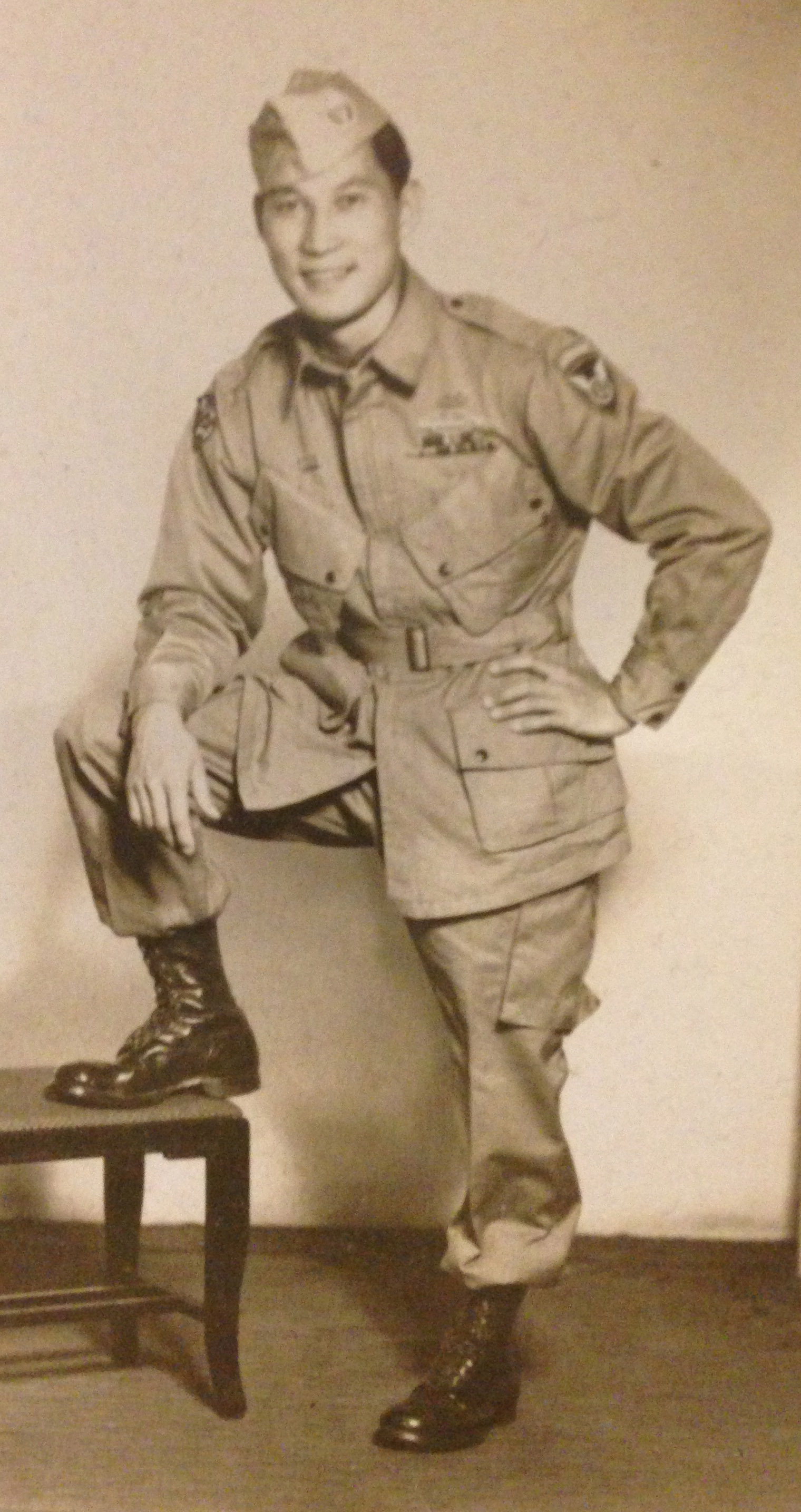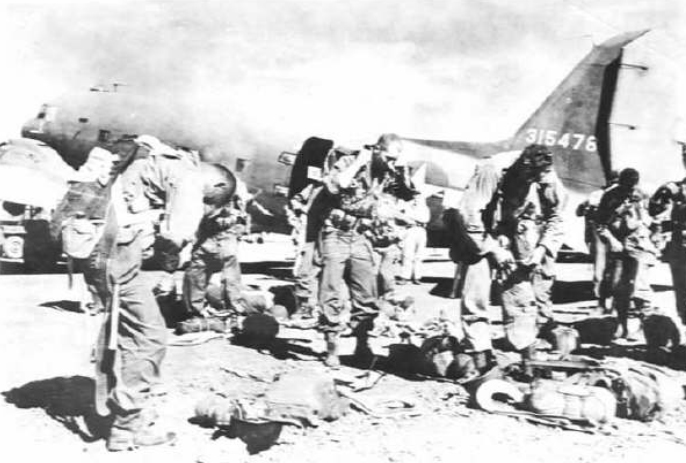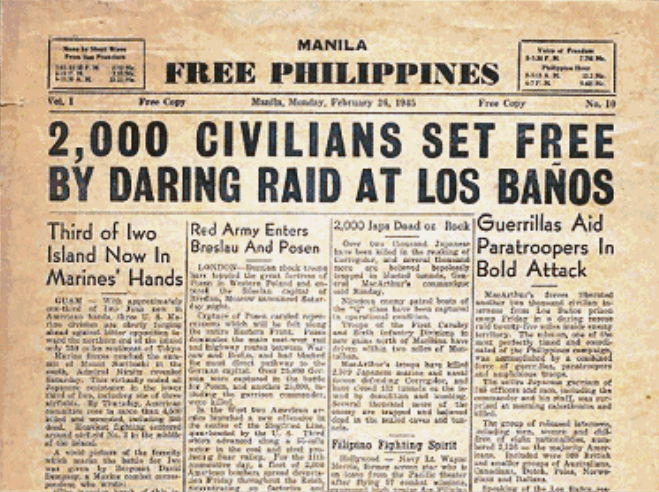Writer’s Note: This day, February 23, 2019 marks the 74th Anniversary of a World War II operation in the Philippines known as The Los Banos Raid. My father was a member of the parachute unit of the 11th Airborne Division deployed in the liberation of the prison camp which held over 2100 civilians. Overshadowed by the Battle of Iwo Jima, this miraculous airborne operation remains virtually as quietly known by the public as the day of the operation.
I originally posted this article last July 4th, 2013 but have decided to repost it today in remembrance of my father, his army comrades and the many family and friends who endured untold suffering and yet exhibited great courage through the storm of world war.
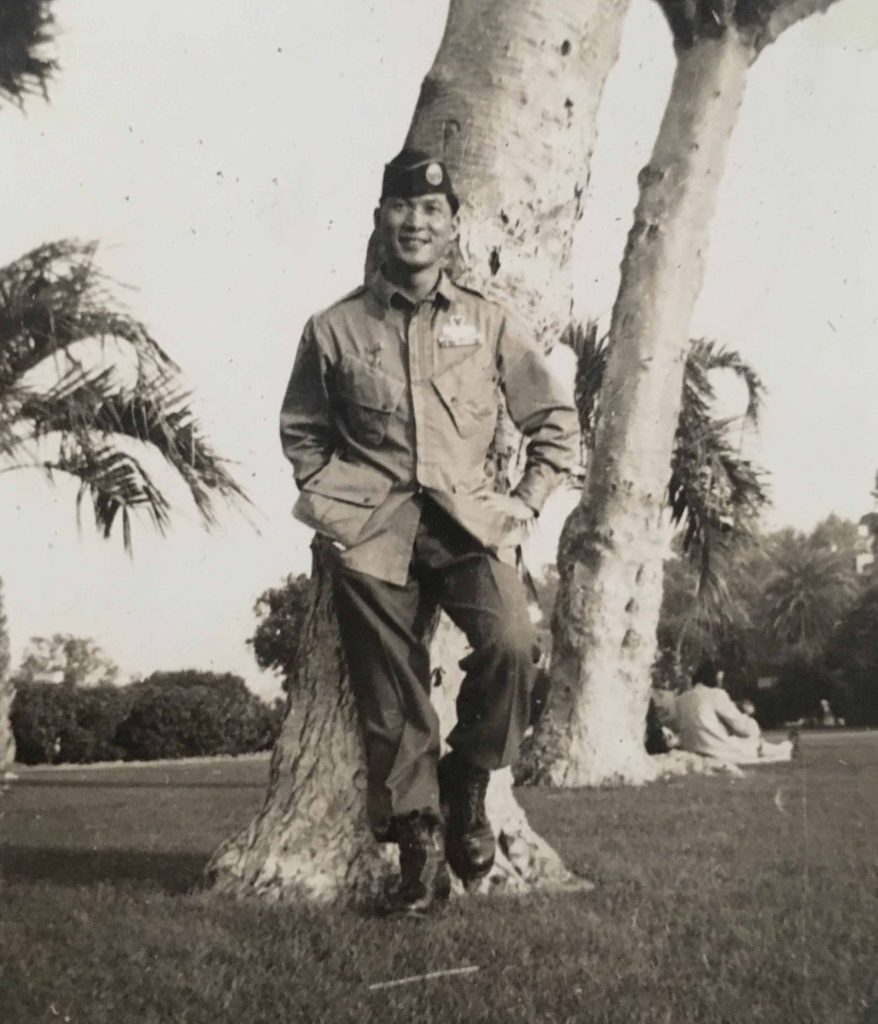
I am not ashamed to say, I could never be looking as cool as my dad the paratrooper. I love this photo. – Challen
Originally posted as
Of Privates and a General – A Father’s story is never fully told
Prelude
As I pondered over a post from a fellow blogger who wrote about keeping track of what you are grateful for, I made a note in my journal , “A father’s story is never fully told.”
As we celebrate Independence Day, and with Father’s Day fading in our wake, I want to look back at an important struggle in both family and military history. As part of my personal and leadership development focus, I have a few reasons to write this:
1) To honor my father by sharing with you some important aspects of his early life. You’ll see life’s joys and sorrows and its peaks and valleys being distinct as they are intertwined.
2) To share a regret expressed by a retired Army general who by any standard had uncommon success as a commander.
3) To recognize by name, a few of my father’s friends who he fought along side with.
I want to say, it’s been an honor in my life to have walked in the presence of these men who lived their lives to the fullest and who seem to embrace every aspect regardless of the pitches they received.
Setting the Stage
Around 1932, my dad came to the United States when he was 12. His family settled in San Francisco.
When they came to the United States, my father had to leave his mother in China as his father immigrated with his second wife (my dad’s step-mother). This separation made a profound impact on my dad’s life.
Dad became more of a maverick than his siblings. Rather than forsaking school to help with the family laundry business, he embraced his new homeland with its western culture, education, and sports. Strong, athletic, a fast learner and street smart, he was popular in his social circles.
With a longing in his heart to see his mother again, World War II began. He had visions of joining the Army to fight his way back to China.
Volunteering for the U.S. Army in 1943, his first goal was to become a pilot. He actually attended and successfully completed pilot ground school but positions for pilots had run out.
My father could not settle for assignment to a regular infantry unit, so when he heard about the paratroops needing volunteers, he “jumped” for it.
Being Chinese and having been naturalized as a U.S. Citizen in basic training, dad had his “Jackie Robinson” moments where race became an issue. But to his credit, my father had a strong sense of who he was and had a way of being diplomatic.
One soldier tried get dad kicked out of training by trying to provoke him into a fight out in town. Sensing trouble, dad invited the man to the camp boxing ring.The invitation was accepted.
There in the safety of the base gym, dad proceeded to show he knew how to box. However, in effort to gain a friend rather than create an enemy, dad pulled his punches without hurting the other guy. The two did become friends and my father earned respect.
Later, my father would remark that, among his paratrooper comrades there was no animosity. They were one team and trusted each other.
He earned his paratrooper “wings”, journeyed with his division to New Guinea for jungle warfare “in theater” training, and made his first combat jump in the Philippines at a place called Taygaytay Ridge.
With American units advancing against entrenched Japanese forces, plans for a special operation were in the making.
The Airborne Raid for the Ages
This story is about a special mission my father, Pfc. Dale F. Yee, took part in. He was a member of a band of brothers known as B-511, a parachute infantry company in WWII.
On February 23rd, 1945, on the Philippine Island of Luzon, an incredible military operation took place. The mission: to liberate over 2000 civilian “internees”: men, women and children from the enemy controlled prison camp at Los Banos.
While several allied units on the ground were involved, the bulk of the assault force was drawn from the 11th Airborne Division, under the command of Major General Joseph M. Swing.
Part of the operation required one parachute infantry company and B-company was available to make the air assault.
Based on intercepted Japanese communications that gave orders to execute all prisoners before withdrawing from advancing American forces, the planned rescue operation was urgently moved up. Secrecy and diversion were critical as a formidable Japanese force known as the “Tiger” Division was within a short distance from the prison and would have been able to overwhelm the smaller airborne units if surprise was compromised.
The day before, the paratroopers were on notice of a secret mission. B-Company, led by Lieutenant John Ringler, was just a bit more rested than their brother companies and closer to a full complement.
They were fed a specially prepared dinner, a nice surprise to the men; however, this sparked rumors of “suicide mission”, “The last meal”, and “pigs fattened for the slaughter.” Operation security was tight, no one was leaving the base, and dawn would come very early.
Transported by C-47 aircraft, the paratroopers made their static-line combat jump at low-altitude (500 feet) at about 7:00 a.m., their drop-zone a short distance outside the gates of the prison.
The timing of the jump coincided with the enemy troops at their morning exercises (standing apart from their weapons). The low altitude jump was made to reduce the chances of being shot out of the air by enemy gunners.
Filipino guerrillas and Army scouts, having quietly positioned themselves in the night around the perimeter of prison, sprang into action.
The airborne soldiers under the canopies of their white chutes filled the sky, like angels from heaven. The sight would forever be beautifully etched in the memories of the internee survivors.
After a short but intense firefight the prison was secured by Allied forces. But, some of the enemy had escaped. Time was of the essence as the ever present threat of a more powerful Japanese counterattack was imminent. Their advance could only be delayed.
The escape plan was to take all the troops and internees by amphibious tractors (AMTRACS) across the nearby lake to the safety of American held territory.
Many of the internees were so shocked with disbelief that they hid in their huts. The paratroopers had to burn the huts to get them to follow the escape plans.
One of the last paratroopers who loaded onto the AMTRACS, along with the rear guard and their pack howitzer cannon, was James “J.B.” King, 457th Field Artillery, 11th Airborne (J.B. would become one of my dad’s closest friends about 36 years later).
Thanks to excellent intelligence, the operation was so well planned and executed, not one internee or member of the immediate assault force was lost during the raid or subsequent evacuation.
A total of 2147, men, women, and children internees were saved from death by execution by their captors. The operation is often referred to as “The Liberation at Dawn.”
Aside from their halo-like red, white, and blue shoulder badge, the men of the 11th Airborne are recognized as the “Angels” and now you know how they earned that name.
Here’s a quote from General Colin Powell: “I doubt that any airborne unit in the world will be able to rival the Los Banos prison raid. It is the textbook airborne operation for all ages and all armies.” (ref. http://www.blackfive.net/main/2005/02/angels_at_dawn_.html)
Lieutenant General Joseph M. Swing
36 years later, meeting in the calm surroundings of a well appointed living room in San Francisco, several local 11th Airborne veterans including some who were involved in the Los Banos Raid, including my father and myself (on active duty in the Navy), had the privilege of meeting General “Jumping Joe” Swing, the Commander of the 11th Airborne in WWII.
We gathered at his home near the Presidio. He was a gentleman in his late 80’s, aided by his beautiful and gracious daughter, Mary Anne Fullilove. The General, still an imposing figure with his tall frame, was very pleased and honored to meet with men of his famed command.
As a combat unit commander, General Swing was concerned about maintaining operational security at all times, particularly restricting press access. The safety of his men and the success of his missions were paramount. As a result, the 11th Airborne did not receive much of the glamor and public attention as did other units with more flamboyant WWII commanders.
As the pages of history and time passed, with the white hairs settled in, the General had some regrets which he expressed to the assembled group. He spoke about his regret that, because of him, his men did not receive their due recognition for their sacrifices in the Pacific War victory.
Naturally, the Airborne soldiers did not fault the General for any lack of acclaim, far from it. They had nothing other than a glowing respect for the man.
Joseph Swing was a leader who cared about the safety of his men and success in victory more than the glory of recognition.
I can think of at least 2147 people, their families and descendants who would agree the General did it right.
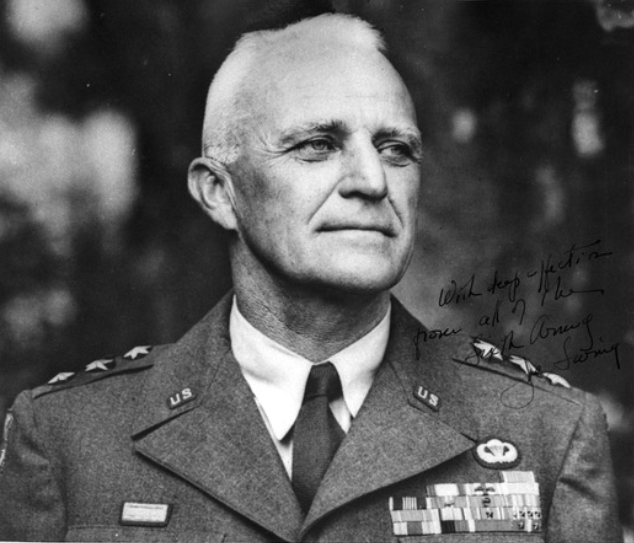
Lt. General Joseph May Swing, Commander, 11th Airborne Division, WWII. image source: trumanlibrary.org
Postlude
For those of you who follow WWII history, you may note that the iconic raising of the Flag at Iwo Jima was on February 23, 1945, the very same day as the Los Banos Raid.
On an operation after the Raid on Los Banos, during the Luzon campaign, B-company was advancing on enemy positions. Dale Yee was the point man and while cresting a hill came under fire from enemy located a stone’s throw away in a foxhole. As he was going for cover, he got caught by an explosion and was blasted several feet into the air “like a rag doll” (according to eye witnesses) from a satchel charge (a hand thrown fragmentation bomb in a sack).
Knocked out, bloodied, and feared dead, he was singlehandedly evacuated from the scene by a machine gunner named Virgil “Skeeter” Young while another squad member, Carl Sampson, provided cover.
The following solemn recollection of the day my father was wounded came from my oldest brother, Nick Yee, who shared this account given to him from our dad. On a Facebook entry on February 23, 2014, Nick wrote: “…After my father was blown up by the satchel charge, he had to be evacuated, with other wounded soldiers. While waiting, my father’s injuries were being tended to by a red-haired medic. Suddenly, they came under heavy machine gun fire. The red-haired medic rolled my father into a ditch, out of harm’s way, saving my father’s life. Unfortunately, the red-haired medic couldn’t save his own. For the rest of my father’s life, he said he forever felt indebted to that brave red-haired medic, and by extension, all redheads. My father was never able to find out the medic’s name.”
As part of the comment, Nick also wrote, “So many great stories out there of brave and heroic deeds…” referring to his friend’s father and of the sea of other accounts told and untold.
That Purple Heart incident ended my father’s combat duty. Amazingly he survived. Full of shrapnel, he was returned to the States for treatment and over a year of rehabilitation. Assessed at 50% disabled, he was discharged from the Army in 1946. But dad didn’t quit, he was given new chance at life and he thrived.
Taking advantage of his GI benefits, dad attended and graduated from U.C. Berkeley. There he met his wife-to-be, Roberta Jong, who won his heart with one of her secret weapons, a pineapple upside-down cake.
They went on to create a family with four children and became self-employed in a variety of businesses.
Virgil “Skeeter” Young retired from the army and ran his own muffler shop in the Los Angeles area.
“J.B.” King settled in Castro Valley, California, and became a carpenter and floor contractor. He also farmed nut trees.
It was not until the 1980’s my parents began attending 11th Airborne reunions, but it was a great opportunity for him to catch up with so many of his airborne brothers.
The reunions took place all around the country, one especially memorable one was in North Carolina when my father was able visit the home of Carl Sampson.
Between Skeeter and Carl, dad was able to piece together what had happened that last day in combat.
***
Unfortunately, my father’s hope of seeing his mother again was never fulfilled this side of heaven.
She passed away in China at the age of 96.
*****
My best wishes to each of you this Independence Day
Challen Yee
July 4, 2013
…..
If you appreciated or learned something of value LIKE COMMENT SHARE
I’ll see you … on the next page

